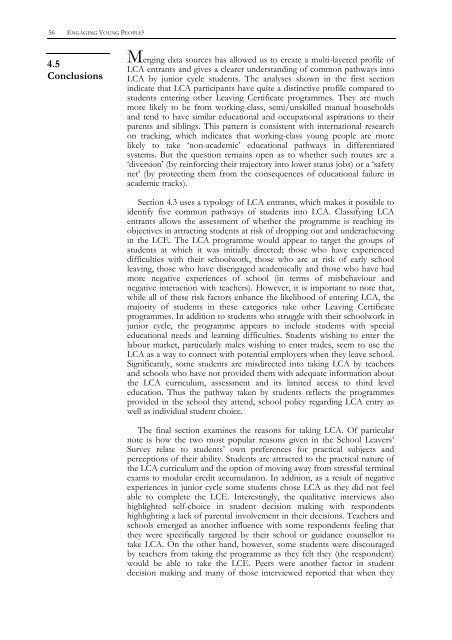Student Experiences of the Leaving Certificate Applied Programme
Student Experiences of the Leaving Certificate Applied Programme
Student Experiences of the Leaving Certificate Applied Programme
You also want an ePaper? Increase the reach of your titles
YUMPU automatically turns print PDFs into web optimized ePapers that Google loves.
56 ENGAGING YOUNG PEOPLE?4.5ConclusionsMerging data sources has allowed us to create a multi-layered pr<strong>of</strong>ile <strong>of</strong>LCA entrants and gives a clearer understanding <strong>of</strong> common pathways intoLCA by junior cycle students. The analyses shown in <strong>the</strong> first sectionindicate that LCA participants have quite a distinctive pr<strong>of</strong>ile compared tostudents entering o<strong>the</strong>r <strong>Leaving</strong> <strong>Certificate</strong> programmes. They are muchmore likely to be from working-class, semi/unskilled manual householdsand tend to have similar educational and occupational aspirations to <strong>the</strong>irparents and siblings. This pattern is consistent with international researchon tracking, which indicates that working-class young people are morelikely to take ‘non-academic’ educational pathways in differentiatedsystems. But <strong>the</strong> question remains open as to whe<strong>the</strong>r such routes are a‘diversion’ (by reinforcing <strong>the</strong>ir trajectory into lower status jobs) or a ‘safetynet’ (by protecting <strong>the</strong>m from <strong>the</strong> consequences <strong>of</strong> educational failure inacademic tracks).Section 4.3 uses a typology <strong>of</strong> LCA entrants, which makes it possible toidentify five common pathways <strong>of</strong> students into LCA. Classifying LCAentrants allows <strong>the</strong> assessment <strong>of</strong> whe<strong>the</strong>r <strong>the</strong> programme is reaching itsobjectives in attracting students at risk <strong>of</strong> dropping out and underachievingin <strong>the</strong> LCE. The LCA programme would appear to target <strong>the</strong> groups <strong>of</strong>students at which it was initially directed; those who have experienceddifficulties with <strong>the</strong>ir schoolwork, those who are at risk <strong>of</strong> early schoolleaving, those who have disengaged academically and those who have hadmore negative experiences <strong>of</strong> school (in terms <strong>of</strong> misbehaviour andnegative interaction with teachers). However, it is important to note that,while all <strong>of</strong> <strong>the</strong>se risk factors enhance <strong>the</strong> likelihood <strong>of</strong> entering LCA, <strong>the</strong>majority <strong>of</strong> students in <strong>the</strong>se categories take o<strong>the</strong>r <strong>Leaving</strong> <strong>Certificate</strong>programmes. In addition to students who struggle with <strong>the</strong>ir schoolwork injunior cycle, <strong>the</strong> programme appears to include students with specialeducational needs and learning difficulties. <strong>Student</strong>s wishing to enter <strong>the</strong>labour market, particularly males wishing to enter trades, seem to use <strong>the</strong>LCA as a way to connect with potential employers when <strong>the</strong>y leave school.Significantly, some students are misdirected into taking LCA by teachersand schools who have not provided <strong>the</strong>m with adequate information about<strong>the</strong> LCA curriculum, assessment and its limited access to third leveleducation. Thus <strong>the</strong> pathway taken by students reflects <strong>the</strong> programmesprovided in <strong>the</strong> school <strong>the</strong>y attend, school policy regarding LCA entry aswell as individual student choice.The final section examines <strong>the</strong> reasons for taking LCA. Of particularnote is how <strong>the</strong> two most popular reasons given in <strong>the</strong> School Leavers’Survey relate to students’ own preferences for practical subjects andperceptions <strong>of</strong> <strong>the</strong>ir ability. <strong>Student</strong>s are attracted to <strong>the</strong> practical nature <strong>of</strong><strong>the</strong> LCA curriculum and <strong>the</strong> option <strong>of</strong> moving away from stressful terminalexams to modular credit accumulation. In addition, as a result <strong>of</strong> negativeexperiences in junior cycle some students chose LCA as <strong>the</strong>y did not feelable to complete <strong>the</strong> LCE. Interestingly, <strong>the</strong> qualitative interviews alsohighlighted self-choice in student decision making with respondentshighlighting a lack <strong>of</strong> parental involvement in <strong>the</strong>ir decisions. Teachers andschools emerged as ano<strong>the</strong>r influence with some respondents feeling that<strong>the</strong>y were specifically targeted by <strong>the</strong>ir school or guidance counsellor totake LCA. On <strong>the</strong> o<strong>the</strong>r hand, however, some students were discouragedby teachers from taking <strong>the</strong> programme as <strong>the</strong>y felt <strong>the</strong>y (<strong>the</strong> respondent)would be able to take <strong>the</strong> LCE. Peers were ano<strong>the</strong>r factor in studentdecision making and many <strong>of</strong> those interviewed reported that when <strong>the</strong>y

















